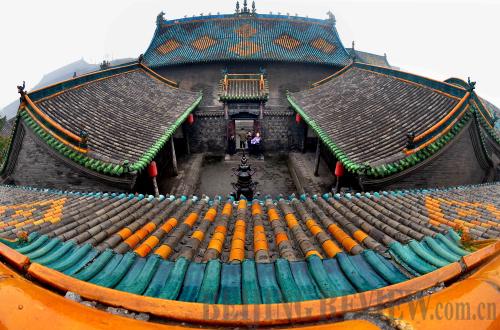|
 |
|
BEING PROTECTED: A building complex dating back to the Ming Dynasty (1368-1644) in Pingyao, a UNESCO-recognized cultural heritage site in north China's Shanxi Province (WANG SONG) |
Xingjiao Temple in Xi'an, capital of northwest China's Shaanxi Province, was built about 1,300 years ago. It houses the relics of Xuan Zang, a famous Buddhist monk and Chinese pilgrim to India during the seventh century. In April, the temple experienced an instant rise to media prominence because of a local government plan to remove large sections of the temple complex. According to the original plan, two thirds of the buildings in the temple, including around 80 rooms—some of which house the monks' dormitories and a dining hall—would be pulled down to make room for foliage.
Although officials explained that the renovation would only affect the surrounding complex built in the 1980s and 90s, the project was met with public opposition and triggered outrage online. According to a government announcement, the renovation is part of the site's preparation for an application for UNESCO World Heritage Site status. If successful, the obtainment of UNESCO's recognition is expected to facilitate the protection of the temple.
"Applying for UNESCO World Heritage status is good and can help protect cultural relics, but how can you protect something by demolishing parts of it?" said Zhang Junyu, a news commentator. "Are you really protecting the cultural relic, or just destroying it?"
The events ended in Xingjiao Temple withdrawing its application, but the debate on the protection of cultural heritage sites in China continues to grow: In what ways should China's numerous cultural relics be protected in the context of rapid economic development?
On September 3, the State Administration of Cultural Heritage released a regulation on the application for UNESCO World Heritage status, stressing protection as the ultimate goal. It also says that application work should be conducted with the aim of revealing and promoting the universal values of cultural heritage sites.
The regulation stipulates that all protective, exhibitive and supervisory efforts for the application should not affect the original state of the said sites.
"Intervention should be kept to a minimum and sites submitting applications should be kept authentic, intact and sustainable for future exhibition and utilization," it says.
Official efforts
According to the third national cultural heritage survey, China is home to around 770,000 sites of historical significance. The huge number of such sites makes relic protection a challenging task in the country.
On May 3, a total of 1,943 cultural properties were added to the national key heritage list. The national key heritage recognition system was launched by the State Council, China's cabinet, in 1961 to allow the Central Government to directly manage and protect relics.
According to Li Xiaojie, head of the State Administration of Cultural Heritage, publishing this list is one of the most effective ways to protect cultural heritage sites against illegal demolition and damage.
Until 2006, 2,352 cultural heritage sites had been added to the list in six batches. This year's seventh update has the largest number of new additions since the start of the system, and brings the total number of entries to 4,295. In addition to the increase in the number of protected sites, the new list has also expanded its coverage from ancient buildings, grottoes and temples to include modern sites with social value, such as old bank buildings and hydropower stations.
| 